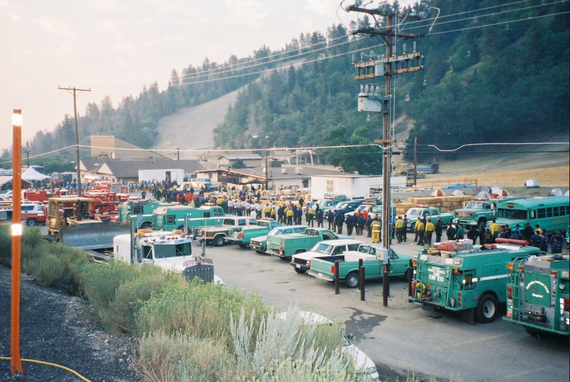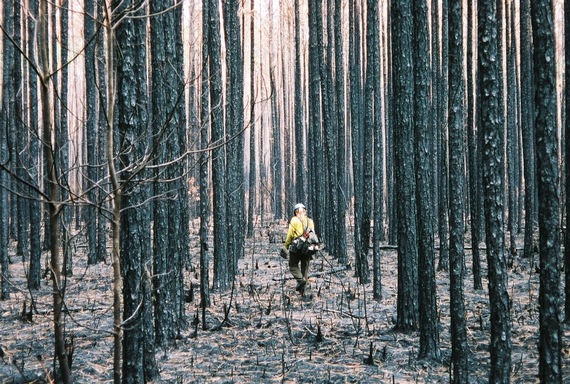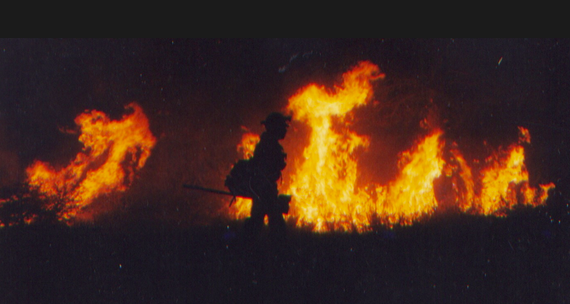Thousands of Southern Californians have fled the wildfires caused by a record drought, Santa Ana winds, and extremely high temperatures. While I feel sympathy for the evacuated residents, who are surely stricken with worry about their homes, I think more about the wildland firefighters battling the blazes in an attempt to protect those homes.
Wildland firefighters have traditionally done much of their exhilarating work in remote and unpopulated areas. But over the last few decades, as residential areas have increasingly been constructed in what experts call wildland-urban-interface areas (WUI) where structures are at risk of being burned by wildfires, firefighters are more and more often called in to defend homes.
Pike Hotshot Bob Schroeder on the Angeles National Forest. Photo by Mary Pauline Lowry
I worked as a wildland firefighter on the Pike Interagency Hotshot Crew for two fire seasons. "Hotshots are the best-trained and best-equipped wildland firefighters, sometimes referred to as the Navy SEALs of their profession" (
Rolling Stone Magazine
). My 20-person hotshot crew traveled the American West chasing wildfires. My first year fighting fire, I had heard many tales of Southern California fires, about the way the fires ripped up the steep hills through the chaparral, driven by the Santa Ana winds. In September, as SoCal residents fled neighborhoods bumping up against the fast burning chaparral, my crew traveled to SoCal to join the 1,200 firefighters working to contain the blaze.
Though accustomed to digging fireline for 14 hours straight, the 28-hour shifts we worked in Southern California came as a shock. We would wake up at 5 a.m., hike four miles or so into the fire, and dig fire line all day. Then at night, once the temperature dropped and the relative humidity rose, we would use a drip torch to light a backfire off of our fireline that would burn back into the main fire, eliminating the fuel ahead of the fire and stopping the main fire in its tracks. But the backfire would inevitably throw sparks across our fireline into the unburned "green" and we would chase spot fires, working to put them out until midday, when we would hike back to fire camp to try to sleep in our tents that heated up in the afternoon sun.

Firefighters wait in line for breakfast at a fire camp in Southern California.
Photo by John Markalunas
Dedicated, adventurous, brutally funny, and often intellectual, my fellow hotshots passed around tattered paperbacks by Hemingway and Krakauer. Yet even as we courted and idealized danger, we planned to live through our youthful adventures. Days when the fire blew up unexpectedly and we had to scramble to make it to our safety zone, we cracked dark jokes about having no desire to die on the fireline.
With California suffering a record drought, the current blazes and resulting evacuations are a harbinger of the fire season ahead. The coming months will find resources across the West stretched thin and wildland firefighters busy. And in danger. Last summer in Arizona, 19 members of the Granite Mountain Hotshots working to defend structures were burned over and died in the Yarnell Hill tragedy. The Yarnell Hill fire had begun as a small lightning strike fire on June 28, and after what has been criticized as a timid early response, grew to the larger blaze that killed 19 firefighters on June 30 and destroyed a quarter of the community.
While my former crewmates and I were heartbroken at the news, all of my firefighter friends balked at the mainstream media's description of the dead as "fallen heroes," seeing it as a pat, reductive way to avoid taking a hard look at why the tragedy occurred. (Outside Magazine, with its in-depth and insightful coverage of the Yarnell tragedy by Kyle Dickman, is one excellent exception to this trend.)

Pike Hotshot Mary Pauline Lowry walks through a burned tree farm.
Photo by John Markalunas
My hotshot friends and I knew that such a tragedy could have befallen us when we were fighting fire, and that if it had, the moniker "fallen hero" would have entirely failed to describe our dedication to each other, our antics, and our love of the work itself. We had understood the risks inherent in wildland firefighting, but also fully expected to live through each fire season. None of us accepted the job "willing to lay down our lives" for the protection of structures.
The increase in WUI areas across the country, the record droughts and high temperatures, and the United States Forest Service's historic policies of total fire suppression (which lasted from the 1920s until the 1970s) have resulted in a growth in the size and intensity of wildfires, which will likely cause increased risk for wildland firefighters in the season ahead, and the years to come.
In order to prevent further deaths of wildland firefighters, it's essential that wildland firefighting agencies implement aggressive "initial attack" strategies against all wildfires in WUI areas to prevent out-of-control conflagrations. It's perhaps even more essential for communities in WUI areas to take immediate initiative and create a defensible space around all structures. Such defensible space can prevent wildfires from burning close enough to ignite properties, and can decrease danger for firefighters working to protect towns. Yes, wildland firefighters are brave and strong and willing to rush towards raging wildfires even as residents flee. But they also should not be put in unnecessarily dangerous situations.
Our 2024 Coverage Needs You
It's Another Trump-Biden Showdown — And We Need Your Help
The Future Of Democracy Is At Stake
Our 2024 Coverage Needs You
Your Loyalty Means The World To Us
As Americans head to the polls in 2024, the very future of our country is at stake. At HuffPost, we believe that a free press is critical to creating well-informed voters. That's why our journalism is free for everyone, even though other newsrooms retreat behind expensive paywalls.
Our journalists will continue to cover the twists and turns during this historic presidential election. With your help, we'll bring you hard-hitting investigations, well-researched analysis and timely takes you can't find elsewhere. Reporting in this current political climate is a responsibility we do not take lightly, and we thank you for your support.
Contribute as little as $2 to keep our news free for all.
Can't afford to donate? Support HuffPost by creating a free account and log in while you read.
The 2024 election is heating up, and women's rights, health care, voting rights, and the very future of democracy are all at stake. Donald Trump will face Joe Biden in the most consequential vote of our time. And HuffPost will be there, covering every twist and turn. America's future hangs in the balance. Would you consider contributing to support our journalism and keep it free for all during this critical season?
HuffPost believes news should be accessible to everyone, regardless of their ability to pay for it. We rely on readers like you to help fund our work. Any contribution you can make — even as little as $2 — goes directly toward supporting the impactful journalism that we will continue to produce this year. Thank you for being part of our story.
Can't afford to donate? Support HuffPost by creating a free account and log in while you read.
It's official: Donald Trump will face Joe Biden this fall in the presidential election. As we face the most consequential presidential election of our time, HuffPost is committed to bringing you up-to-date, accurate news about the 2024 race. While other outlets have retreated behind paywalls, you can trust our news will stay free.
But we can't do it without your help. Reader funding is one of the key ways we support our newsroom. Would you consider making a donation to help fund our news during this critical time? Your contributions are vital to supporting a free press.
Contribute as little as $2 to keep our journalism free and accessible to all.
Can't afford to donate? Support HuffPost by creating a free account and log in while you read.
As Americans head to the polls in 2024, the very future of our country is at stake. At HuffPost, we believe that a free press is critical to creating well-informed voters. That's why our journalism is free for everyone, even though other newsrooms retreat behind expensive paywalls.
Our journalists will continue to cover the twists and turns during this historic presidential election. With your help, we'll bring you hard-hitting investigations, well-researched analysis and timely takes you can't find elsewhere. Reporting in this current political climate is a responsibility we do not take lightly, and we thank you for your support.
Contribute as little as $2 to keep our news free for all.
Can't afford to donate? Support HuffPost by creating a free account and log in while you read.
Dear HuffPost Reader
Thank you for your past contribution to HuffPost. We are sincerely grateful for readers like you who help us ensure that we can keep our journalism free for everyone.
The stakes are high this year, and our 2024 coverage could use continued support. Would you consider becoming a regular HuffPost contributor?
Dear HuffPost Reader
Thank you for your past contribution to HuffPost. We are sincerely grateful for readers like you who help us ensure that we can keep our journalism free for everyone.
The stakes are high this year, and our 2024 coverage could use continued support. If circumstances have changed since you last contributed, we hope you'll consider contributing to HuffPost once more.
Already contributed? Log in to hide these messages.


